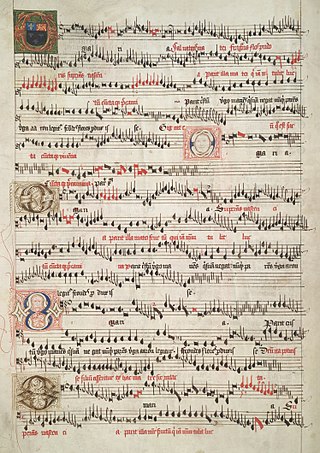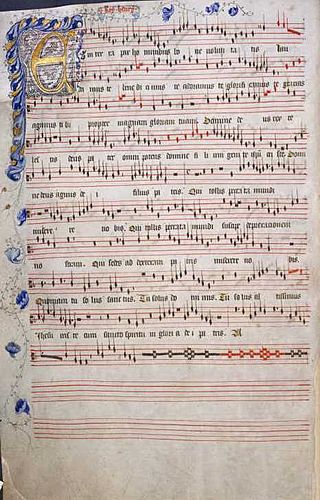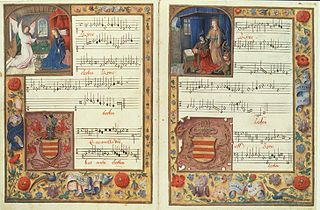
Samuel Pepys was an English writer and Tory politician. He served as an official in the Navy Board and Member of Parliament, but is most remembered today for the diary he kept for almost a decade. Though he had no maritime experience, Pepys rose to be the Chief Secretary to the Admiralty under both Charles II and James II through patronage, diligence, and his talent for administration. His influence and reforms at the English Admiralty were important in the early professionalisation of the Royal Navy.
William Cornysh the Younger was an English composer, dramatist, actor, and poet.

The Pepys Library of Magdalene College, Cambridge, is the personal library collected by Samuel Pepys which he bequeathed to the college following his death in 1703.
A chansonnier is a manuscript or printed book which contains a collection of chansons, or polyphonic and monophonic settings of songs, hence literally "song-books"; however, some manuscripts are called chansonniers even though they preserve the text but not the music, for example, the Cancioneiro da Vaticana and Cancioneiro da Biblioteca Nacional, which contain the bulk of Galician-Portuguese lyrics.

The Eton Choirbook is a richly illuminated manuscript collection of English sacred music composed during the late 15th century. It was one of very few collections of Latin liturgical music to survive the English Reformation, and hence is an important source. It originally contained music by 24 different composers; however, many of the pieces are damaged or incomplete. It is one of three large choirbooks surviving from early-Tudor England.

Roy Henry was an English composer, almost certainly the pseudonym of an English King: probably Henry V, but also possibly Henry IV. His music, two compositions in all, appears in a position of prominence in the Old Hall Manuscript.

A partbook is a format for printing or copying music in which each book contains the part for a single voice or instrument, especially popular during the Renaissance and Baroque. This format contrasts with the large choirbook, which included all of the voice parts and could be shared by an entire choir. The choirbook still followed the convention to notate the parts separately, but within a double page, likewise part books were arranged that they show the one extract of the composition on the same page.

The Reliques of Ancient English Poetry is a collection of ballads and popular songs collected by Bishop Thomas Percy and published in 1765.
Firminus Caron was a French composer, and likely a singer, of the Renaissance. He was highly successful as a composer and influential, especially on the development of imitative counterpoint, and numerous compositions of his survive. Most of what is known about his life and career is inferred.
John Browne was an English composer of the Tudor period, who has been called "the greatest English composer of the period between Dunstaple and Taverner". Despite the high level of skill displayed in Browne's compositions, few of his works survive; Browne's extant music is found in the Eton Choirbook, in which he is the best-represented contributor, and the Fayrfax Manuscript. His choral music is distinguished by innovative scoring, false relations, and unusually long melodic lines, and has been called by early music scholar Peter Phillips "subtle, almost mystical" and "extreme in ways which apparently have no parallel, either in England or abroad."

A choirbook is a large format manuscript used by choirs in churches or cathedrals during the Middle Ages and Renaissance. The book is large enough for the entire choir to read from one book. Choirbooks were generally put on a stand with the smaller boy sopranos in front and the men in back. As the printing of music became easier and paper replaced vellum, choirbooks fell out of favour, replaced by smaller, cheaper, and easier to handle partbooks and octavos.
The Ritson Manuscript is a late fifteenth-century English choirbook, that is a major source for English carols. In addition to 44 carols, it includes three masses, 23 motets, several other sacred pieces, and secular works in English and French. Among the composers represented in the book is Sir William Hawte.
The Lambeth Choirbook – also known as the Arundel Choirbook – is an illuminated choirbook dating to the sixteenth century. It contains music for 7 Masses, 4 Magnificats, and 8 motets. Much of the music is by Tudor-period composers. The major contributors are Robert Fayrfax and Nicholas Ludford; between them they contributed at least ten of its nineteen pieces. Only three of Fayrfax's works have his name attached to them, but five other pieces are known as his; these, along with two by Ludford, are known from concordances in the Caius Choirbook and other manuscripts. Seven anonymous pieces exist in the book:
The Caius Choirbook is an illuminated choirbook dating to the early sixteenth century and containing music by Tudor-period composers. The book appears to originate from Arundel in Sussex, and to have been created sometime in the late 1520s; the then Master of Arundel College, Edward Higgons, seems to have presented it to the collegiate chapel of Saint Stephen's in Westminster, where he was a canon beginning in 1518. The choirbook is now housed at Gonville and Caius College, Cambridge.
Nicholas Ludford was an English composer of the Tudor period. He is known for his festal masses, which are preserved in two early-16th-century choirbooks, the Caius Choirbook at Caius College, Cambridge, and the Lambeth Choirbook at Lambeth Palace, London. His surviving antiphons, all incomplete, are copied in the Peterhouse partbooks, which disappeared from view until some were rediscovered in 1850, and the rest only in 1926.
Gilbert Banester was an English composer and poet of Flemish influences.
Daniel Skinner was an amanuensis of John Milton. He is best known for his role in the posthumous attempts to publish, and then for trying to suppress, several of Milton's State Papers, including De Doctrina Christiana.
Christian Hollander was a Dutch composer.

Drexel 4180–4185 is a set of six manuscript partbooks copied in Gloucester, England, containing primarily vocal music dating from approximately 1615-1625. Considered one of the most important sources for seventeenth century English secular song, the repertoire included represents a mixture of sacred and secular music, attesting to the partbooks' use for entertainment and pleasure, rather than exclusively for liturgical use.
The Forrest-Heyther partbooks are a set of six manuscript partbooks copied in England in the sixteenth century. They are an important source of polyphonic Mass Ordinary settings by composers from the reign of Henry VIII, including John Taverner and Robert Fayrfax.







